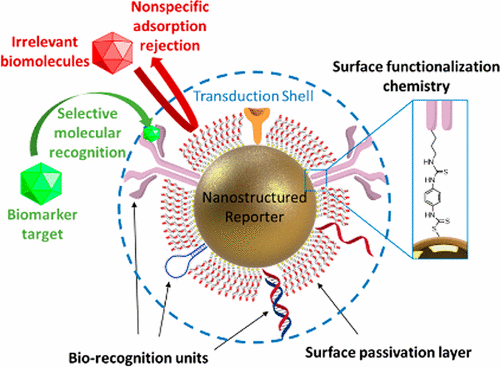当前位置:
X-MOL 学术
›
Chem. Rev.
›
论文详情
Our official English website, www.x-mol.net, welcomes your feedback! (Note: you will need to create a separate account there.)
Synthesis, Assembly, and Applications of Hybrid Nanostructures for Biosensing
Chemical Reviews ( IF 62.1 ) Pub Date : 2017-09-13 00:00:00 , DOI: 10.1021/acs.chemrev.7b00088 Shuaidi Zhang 1 , Ren Geryak 1 , Jeffrey Geldmeier 1 , Sunghan Kim 1 , Vladimir V. Tsukruk 1
Chemical Reviews ( IF 62.1 ) Pub Date : 2017-09-13 00:00:00 , DOI: 10.1021/acs.chemrev.7b00088 Shuaidi Zhang 1 , Ren Geryak 1 , Jeffrey Geldmeier 1 , Sunghan Kim 1 , Vladimir V. Tsukruk 1
Affiliation

|
The robust, sensitive, and selective detection of targeted biomolecules in their native environment by prospective nanostructures holds much promise for real-time, accurate, and high throughput biosensing. However, in order to be competitive, current biosensor nanotechnologies need significant improvements, especially in specificity, integration, throughput rate, and long-term stability in complex bioenvironments. Advancing biosensing nanotechnologies in chemically “noisy” bioenvironments require careful engineering of nanoscale components that are highly sensitive, biorecognition ligands that are capable of exquisite selective binding, and seamless integration at a level current devices have yet to achieve. This review summarizes recent advances in the synthesis, assembly, and applications of nanoengineered reporting and transducing components critical for efficient biosensing. First, major classes of nanostructured components, both inorganic reporters and organic transducers, are discussed in the context of the synthetic control of their individual compositions, shapes, and properties. Second, the design of surface functionalities and transducing path, the characterization of interfacial architectures, and the integration of multiple nanoscale components into multifunctional ordered nanostructures are extensively examined. Third, examples of current biosensing structures created from hybrid nanomaterials are reviewed, with a distinct emphasis on the need to tailor nanosensor designs to specific operating environments. Finally, we offer a perspective on the future developments of nanohybrid materials and future nanosensors, outline possible directions to be pursued that may yield breakthrough results, and envision the exciting potential of high-performance nanomaterials that will cause disruptive improvements in the field of biosensing.
中文翻译:

杂化纳米结构的合成,组装及其在生物传感中的应用
通过预期的纳米结构对天然环境中的目标生物分子进行强大,灵敏和选择性的检测,对于实时,准确和高通量生物传感具有广阔的前景。但是,为了具有竞争力,当前的生物传感器纳米技术需要进行重大改进,尤其是在复杂生物环境中的特异性,集成度,吞吐率和长期稳定性方面。在化学“嘈杂”的生物环境中发展生物传感纳米技术需要对纳米级组件进行仔细的工程设计,这些组件是高度灵敏的,具有良好选择性结合能力的生物识别配体,并且在目前水平的设备上尚未实现无缝集成。这篇评论总结了合成,组装,纳米工程报告和转导组件的应用及其对高效生物传感至关重要。首先,在合成控制它们各自的组成,形状和特性的背景下,讨论了主要类别的纳米结构组分,包括无机报告分子和有机传感器。其次,对表面功能和传导途径的设计,界面体系结构的表征以及将多个纳米级组件集成到多功能有序纳米结构中进行了广泛的研究。第三,回顾了由杂化纳米材料创建的当前生物传感结构的示例,并特别强调了针对特定操作环境定制纳米传感器设计的需求。最后,
更新日期:2017-09-13
中文翻译:

杂化纳米结构的合成,组装及其在生物传感中的应用
通过预期的纳米结构对天然环境中的目标生物分子进行强大,灵敏和选择性的检测,对于实时,准确和高通量生物传感具有广阔的前景。但是,为了具有竞争力,当前的生物传感器纳米技术需要进行重大改进,尤其是在复杂生物环境中的特异性,集成度,吞吐率和长期稳定性方面。在化学“嘈杂”的生物环境中发展生物传感纳米技术需要对纳米级组件进行仔细的工程设计,这些组件是高度灵敏的,具有良好选择性结合能力的生物识别配体,并且在目前水平的设备上尚未实现无缝集成。这篇评论总结了合成,组装,纳米工程报告和转导组件的应用及其对高效生物传感至关重要。首先,在合成控制它们各自的组成,形状和特性的背景下,讨论了主要类别的纳米结构组分,包括无机报告分子和有机传感器。其次,对表面功能和传导途径的设计,界面体系结构的表征以及将多个纳米级组件集成到多功能有序纳米结构中进行了广泛的研究。第三,回顾了由杂化纳米材料创建的当前生物传感结构的示例,并特别强调了针对特定操作环境定制纳米传感器设计的需求。最后,



























 京公网安备 11010802027423号
京公网安备 11010802027423号